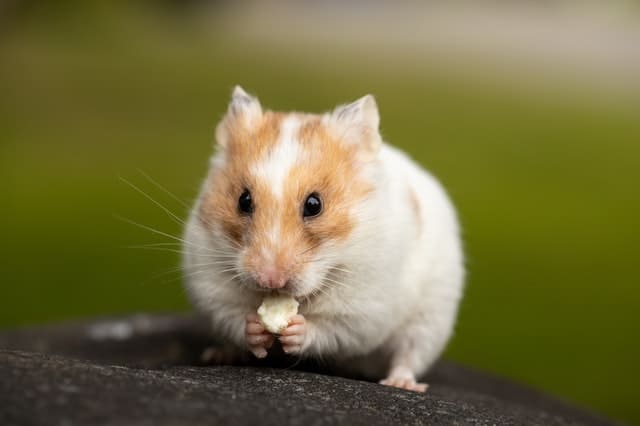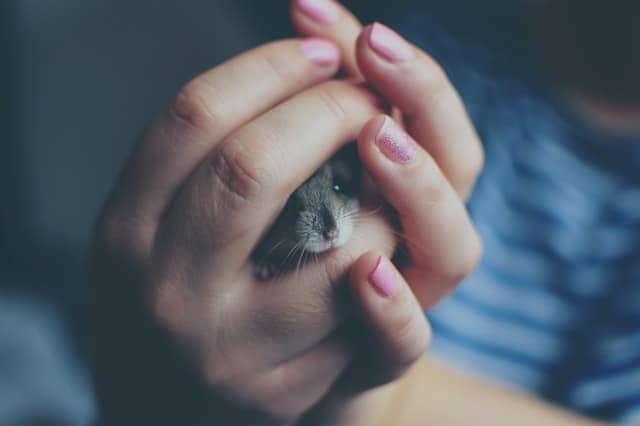
Is the hamster right for you?
- Check that you are not allergic to dust or hair
- The hamster needs a place where it will be quiet during the day, but can make noise at night
- Cigarette smoke, drafts and noise make him sick.
- This animal requires daily and weekly attentions concerning its food as well as the cleaning of the cage.
- Offer him temporary activities. An existence without change is detrimental to it.
- Hamsters like to roam outside their cages – which means dirt in the room and gnawing marks.
- Think about the potential risks posed by other animals in the household.
- During the holidays, it is better to entrust the care of the hamster to someone you trust and not to take it with you.
- Recommended age for a child: From eight years old, with the assistance of parents.
Hamsters are adorable , they have soft fur and cute eyes. No wonder children fall under their spell. But the hamster is a living and sensitive being and must be treated accordingly. Don’t put the animal under the Christmas tree just because your child really wants it.
A hamster is only the ideal animal if your child has a sufficient sense of responsibility. It is not suitable for children before primary school. Bigger, a kid can make a good healer, but always keep an eye on what’s going on. Observe how your child behaves with the animal, teach him things to watch out for.
The hamster cannot defend itself if a child who mistreats it (unwittingly). For example, if you drop it, it can cause very painful internal injuries or fractures of the ribs or limbs. At worst, the “game” can have a fatal outcome. Teach your child that the hamster is not a toy, that it has its own personality and that its needs must be met.
If it’s a hamster you want, teach your child that sleep is very important for the animal and should be respected by all family members! Lack of sleep is a source of stress and negatively influences the health and life expectancy of the hamster.
Important: Hamsters are crepuscular and nocturnal animals. Ask yourself if your children want a pet that wakes up when they go to bed. The dwarf hamsters are more flexible and are often busy during the day, sometimes adapting to the sleep rhythm of their owners.
Ten questions to ask yourself before buying or adopting a hamster
Being a good foster family for a hamster means being able to ask the right questions.
1. A hamster needs a suitable place, where it can sleep all day without being disturbed, but where it is also allowed to make noise in the evening and at night.
2. He wants a clean cage, and fresh food every day. This is quite a bit of work and takes time.
3. While it is true that he does not like to be constantly stroked, the hamster will only be tamed if you take care of him every day.
4. While sleeping, he needs absolute calm. It is only on this condition that he will be able to live as long as possible, that is to say from two to four years.
5. You need to be sure that someone will take care of him during the holidays.
6. Hamsters like movement and should also be able to walk outside of their cage, in a closed room.
7. It may happen that, in these moments of freedom, the hamster nibbles wallpapers, baseboards, or linen.
8. He needs the largest possible cage, in which he has enough freedom of movement.
9. If you already have any other pets , you must be wondering what the safety of the hamster will be.
10. Above all, don’t forget to check that no family member is allergic to animal hair.
Don’t buy out of compassion!
Even if it hurts your heart, never buy an animal because its living conditions are terrible. There is a great danger that the animal is sick or suffers from behavioral disorders.
Moreover, such a purchase rewards the amoral conduct of the seller, who will persevere in this path. Hamsters that no one buys end up as animal feed or simply thrown away. It is better to report the negligence of the seller to an animal protection association.
Danger to the Hamster from Other Animals

Of course, you can own other animals at the same time as a hamster. It is only a question of organization. The main thing is to devote enough time to everyone. A poorly managed home zoo is stressful for you and for the animals.
Hamsters do not care about the company of other pets, and usually it is not possible to keep them together. We can only advise against attempts in this direction. Of course, there are always exceptions, but your cat is unlikely to be just that exception and, unlike thousands of others, will not view the hamster as tempting prey.
If it comes across a stronger enemy, the hamster will drop backwards and play dead.
Hamsters and dogs and cats
Cats and dogs can eat or injure the hamster. Hamsters are coveted prey. In the wild , they have to fight for their survival every day, as many predators lie in wait for them. Our domestic hamsters are just as fearful. It is therefore understandable that they do not like to be chased by a dog or a cat.
A peaceful cohabitation between prey and predator is certainly possible, but only under certain conditions. In any case, you should never leave a hamster alone in the wild in a room with a cat or a dog . There must always be someone watching them. Dogs and cats are in the blood of hunting and there is always a risk.
Hamsters and birds
Large birds like parrots or parakeets can nip it. Small birds like canaries can, on the other hand, be bitten by the hamster. A budgie or canary is not dangerous for the hamster, unlike large parakeets and jealous large parrots, whose beaks can inflict serious injuries.
Never let your hamster roam unsupervised when the bird is free. The hamster cage and the bird cage should not be in the same room, as the incessant songs or cries of the latter disturb the sensitive ears of the rodent.
Hamsters and other rodents
With other rodents such as mice, gerbils, squirrels, we can witness serious clashes. Don’t assume that all rodents get along with each other. Most hamsters cannot stand their fellows, let alone other species. Never house another hamster in the same cage as other rodents, this will not work.
Hamsters with other animals
Caution is advised with all carnivores, including lizards, agamas and snakes, but also ferrets. Finally, never let your hamster wander near an aquarium , it might fall and drown.
Possible things at home that can cause harm to Hamster
| Sources | Consequences | Precautions to be taken |
| Electric cable | Discharge, if it attacks the envelope with the teeth. | Embed the lines, do not leave bare cables under tension, disconnect the sockets when exiting. |
| Stained or lacquered wood | Allergy, poisoning if swallowed. | Prevent the hamster from gnawing on the wood, divert its attention from the object. |
| Water containers | Risk of slipping and drowning. | Watch the animal well during its outings |
| Hot objects | Risk of burns. | Do not allow it to circulate near a toaster or stove. |
| Cage bars | Risk of escaping if the gap is too large, of poisoning if they are rusted. | Choose a bar spacing between 1 and 1.3 cm, replace the cage if it is rusty. |
| Air vents | Risk of escape. | Watch the animal well during its outings. |
| Human foot | Risk of being trampled and crushed. | Watch the animal well during its outings. |
| Plants | Poisoning, often fatal (ask the florist or consult a guide). | Give up growing poisonous plants in the hamster’s immediate surroundings. |
| Cabinets, drawers | If the hamster is accidentally locked there, it can starve or suffocate. | Return the hamster to its cage after each outing. |
| Seats | Risk of being crushed if someone sits on it. | Watch the animal well during its outings. |
| Sun | Heatstroke. | Never leave the cage in direct sunlight. |
| Sharp objects (pins, nails) | Risk of tearing cheekbones. | Do not leave such objects lying around. |
| Table | Fall, risk of fractures or internal injuries. | Make sure the hamster does not escape from the cage. |
| Doors | Risk of getting caught or pinched or crushed. | Keep doors closed when going out. |
Should you buy a single Hamster or a Couple?
Most species of hamsters are naturally solitary, and this is especially true of the golden hamster . They don’t mind living alone. There are many exceptions in certain breeds, but beware: cohabitation can turn badly from day to day! You will have to intervene without delay and separate the animals.
As soon as the animals are purchased, get a second cage so that you can immediately separate the rivals. Above all, don’t wait and hope that things will work out. When hamsters start to fly in the hair, civil war is guaranteed. For the dominated individual, this can end in serious injury, as he does not have the opportunity to escape into the tight space of the cage.
In the case of dwarf hamsters , as a general rule, it is easier to maintain family ties when dwarf hamsters have known each other since they were all young. In this respect, it is the Dzungarian hamsters and the Campbell hamsters which pose the least difficulty. As for the Roborowski dwarf hamsters, it is possible to keep them in small groups, but only with congeners of the same sex.
A single hamster is much easier to care for than a couple. Hamsters are loners. Even in their natural environment, they do not live in society. Males and females do not come together until mating, and then separate very quickly. And the females themselves only live a few weeks with their young.
A hamster living alone under the protection of humans therefore does not need the company of a congener. On the contrary – one can see heavy fighting when two hamsters are confronted with each other, especially if the cage is small.
A couple, I do not recommend the acquisition if you want to reproduce. It is true that brother and sister of the same litter manage to support each other. But it is enough that they are separated for a few days and, already, they lack the main mark of recognition: the smell of the group.
They then inflict bites on each other which can be dangerous and, most of the time, it becomes almost impossible to get them accustomed to each other again. But even in cases where they have not been separated, there may be difficulties. There may be times when the dominant animal, the more active of the two, threatens the other and pushes it away from the feeder or nest, and this constant stress can cause the weaker animal to waste away.
My advice: the more spacious the cage, the more interesting and varied its layout , offering multiple hiding possibilities, the less risk of fights.
Should you buy a Male Hamster or a female Hamster ?
In fact, the sex of the animal is of little importance. It is said that females have worse characters than males, but there are also snarling males. Females are a little larger and their activity is conditioned by their hormonal cycle. They are in heat every four days and their sexual organs secrete a liquid with a slightly pronounced odor.
If you want to breed multiple hamsters together, take them all of the same sex, unless you want to breed them . Otherwise, you will quickly have unwanted litters. Do not neuter or neuter your hamsters. The risk is too great that your companions will not survive the anesthesia.
In general, young hamsters are given between four and six weeks old. At this age, the sexual characteristics are already recognizable, at least for a trained person, which is the case with breeders and sellers. For a beginner, the exercise is not that simple. Lift the hamster up and gently turn it over onto its back. In the female, the two orifices – anus and vulva – are closer together than in the male, and the croup is more rounded; from the seventh week, the testes of males are visible.
It doesn’t matter which gender you decide to choose, even though males are said to tame faster. At the time of purchase, pick the hamster that appeals to you the most.
How to determine the sex : Any good dealer or breeder will tell you about the sex of animals. Be aware, however, that in males, the distance between the anal opening and the genital opening is significantly greater than in females.
On the other hand, males have a pointy hindquarters. In adult males (from the 4th or 5th week), one can clearly recognize the testes, located on either side of the anal opening.
What species of Hamster to buy?
The golden hamster is the most famous representative of the hamster family. He is originally from Syria and his learned name is Mesocricetus auratus. Next to this tawny-colored variety, you can find other varieties, always of the golden hamster species, which stand out for their appearance and character.
The dwarf hamster is less well known. However, two varieties are increasingly available in pet stores: the Chinese striped hamster (Cricetulus griseus) and the dzoungare dwarf hamster (Phodopus sungorus). They demand the same care as their larger counterparts. But because they are tiny and have a propensity to constantly hide, they are less amenable to being chosen as pets. Children, in particular, have trouble catching these twirling dwarves, which slip too easily from their hands.
A word of advice for beginners: buy a golden hamster that is fawn in color. It is the most robust species, the closest to the wild hamster . Colored varieties obtained by crossing are more fragile.
For more information on this subject, visit the page of the different breeds of hamster.
Where to get a hamster?
In any good pet store or in the specialized departments of department stores, it is almost always easy to find. But maybe you also know someone in your neighborhood who has young hamsters to donate.
Not recommended: mail order sales. Transport by train or post is torture for the animal. Also, you are not sure whether it arrives at your home healthy.
Buy a hamster from a pet store
In a pet store, you will certainly find what you are looking for if you have no particular wishes in terms of hair or color. Before buying an animal, it is imperative to check its accommodation conditions. Buy only if cages and animals are clean. Dirty cages, spoiled food scraps and dirty animals betray poor hygiene. The frequent result is that animal health suffers. Take the time and observe them for a long time before you decide. It is best to go to the store in the evening to see the hamsters in action.
Important: You must know if it is a male or a female that you are buying. Find out about the sex of your future companion. The salesperson must be able to recognize the sexes. If he claims it’s impossible at the age of the animals, change stores. At the age when the young are separated from their mother, they are old enough for a trained person to recognize the sexual characteristics.
Buy a hamster from breeders
If you are looking for a particular breed or variant , you have a good chance of finding it in a breeder. As an added advantage, you will be able to see for yourself the quality of the breeding conditions. But here too, observe carefully how the animals are housed. Unfortunately, there are also black sheep among breeders who are little motivated by the passion for animals.
If you don’t find anything to complain about, nothing stands in the way of the acquisition. The breeder will be able to inform you about the age and sex of his animals. If you are going into breeding a couple, you can also choose a sibling from the same litter. Breeders advertise in newspapers and on the internet.
Buy a hamster in an animal shelter
It is not essential to buy young animals. Older hamsters also rejoice in finding loving homes. Of course, the animal should not be too old either. His life expectancy is not very high and you should be able to take advantage of him. But we also find a lot of young people in shelters, which often take in unwanted children. Staff can inform you about their age, gender and any illnesses.
Buy a hamster from individuals
There is no shortage of private sellers and you will find them near you thanks to the Internet or the newspapers. The animals offered are generally unwanted little ones, but there are also adults. In the latter case, chances are you can buy the material from the same person as well. In this type of transaction, you can do good business, it costs nothing to ask. There are internet forums that can help you find a home for your hamsters.
Five tips for buying a Hamster
- A knowledgeable animal dealer will give you advice . But if you are very undecided, bring a friend who knows the subject with you.
- Preferably choose the afternoon to make this purchase, this is the time when the hamsters come alive and you can better observe them.
- Prefer a young hamster of three to four weeks.
- Pay close attention to any signs of illness .
- If possible, take some litter from the original cage with the hamster to ” decorate ” its new home. In this unfamiliar place, he will smell at least one familiar scent, which will decrease the stress of acclimatization.
How to Choose the right hamster
A healthy hamster has a smooth, shiny coat, an almost perfectly cylindrical shaped body, a clean anal opening, shiny, discharge-free eyes, and a dry nose. A sick hamster has a ruffled, dull coat, hollow flanks, a dirty anal opening, inflamed eyes, and a runny nose. If, in addition, it wobbles on its legs, shakes, sneezes or groans, do not buy it. Assessment of health prior
It’s decided, you are ready to take care of a hamster and you have already spotted one. Good. However, despite your enthusiasm, now is the time to keep a cool head and not rush home with the animal right away. Start by observing it carefully to avoid buying a sick animal.
- The hamster is not listless, it is curious and active.
- His eyes are bright, clear and do not sink.
- The coat is thick and clean, with no bare areas or scabs.
- The nose is dry, without redness or discharge (sneezing)
- The incisors and claws are not too long; beware of dental malocclusions.
- He doesn’t have bad breath.
- He can fill and empty his cheekbones without difficulty.
- He does not limp, the soles are clean and have no injuries.
- The anal region is clean; soiling can indicate an intestinal disorder.
- The stomach is soft. A hard, swollen belly can be the result of poor nutrition or a gastrointestinal condition.
- He is neither too fat nor too thin (the bones do not protrude).
- The back is straight.
- Breathing is calm and regular, without snoring or other abnormalities.









